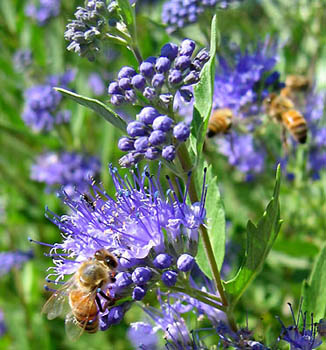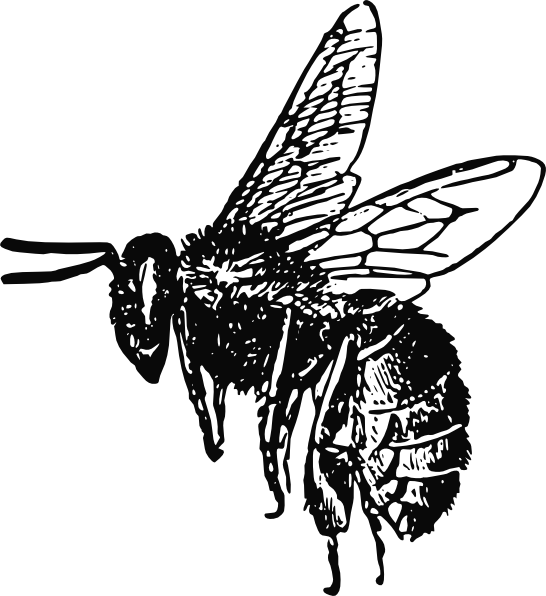Orchard Mason Bees (OMBs) are approximately half the size of a true honey bee and are recognized by many names including the Blue Mason Bee describing their dark blue iridescent body color similar to that of a house fly, a common quick-glance identification mistake. They have a docile disposition common for a "solitary" bee having no need to protect a hive, therefore only when feeling imminently threatened by being handled roughly or trapped under clothing will they be forced to sting. Their sting is low in venom and more comparable to that of a mosquito bite.
Orchard Mason Bees are true Northwest troopers! During these unpredictable spring weather patterns you will find them happily buzzing about their business on even the cloudiest day and weeks ahead of their fair weather friends. True to their name, the Orchard Mason Bee is a key fruit tree pollinator but also do well foraging under the forest canopy for early blooming natives like Oregon Grape and Flowering Currant. Studies show that it takes about 250 nesting female OMBs, or 3-4 per fruit tree to pollinate a one acre orchard whereas it would take 1-2.5 honey bee hives housing thousands of honey bees to pollinate the same acreage. The pollen collected by the OMB provides food that will be stored to feed their future offspring as they emerge the following year prepared to repeat this important and short life cycle.
 |
| Resting OMB on nesting tube |
 | |||||||||
| Cocoons & stored pollen |
 |
| Raindrop Mason Bee House from Crown Bee |
Beginning in 2006 there has been an alarming amount of evidence piling up documenting a decline in pollinating bee populations and especially in the case of the Western Honeybee, Apis mellifera. This continued mystery surrounding the disappearance of bees is being referred to as Colony Collapse Disorder (CCD) and possible contributing factors include infectious diseases, environmental stress and perhaps most concerning is pesticide exposure and poisoning. Many field crop producers implement the use of pesticides as a means of pest control not realizing where bee pollinators are being used this pesticide application then coats the pollen that is then collected and brought back to the hive as food subjecting the colony to this non-discriminatory chemical agent.
One way we can help reduce possible risk to the bee population, not to mention other beneficial insects, animals, ourselves and the environment we live in as a whole, is to reduce the use of pesticides. Better yet, STOP using pesticides all together. As we become more aware and educate ourselves on the dangers and hidden effects of chemicals in our environment, implementing the use of safer alternatives should always be the first approach. In the event that you feel it necessary to use pesticides (which I am in no way advocating) it is important to first educate yourself on the pesticide you are using and it's effects on both the intended target and risk it poses to other unintended targets such as birds that may be feeding on the targeted pests playing a key role in natures intended pest control. As with any organic or synthetic pesticide products, apply them early in the morning and late in the evening when our friendly pollinators are less likely to be out foraging.
To encourage healthy populations of pollinators both native and non native think about providing and encouraging nesting sites like the Orchard Mason Bee boxes mentioned above and consider gardening with plants that will provide good sources of nectar including native plants. Many of these plants double as attractors for other welcomed gardens guests too like Hummingbirds and Butterflies! I've listed some of my favorites below.
Pacific Northwest Natives include:
 |
| OMB on Oregon Grape flower |
Mahonia nervosa or aquifolium, Oregon Grape
Ribes sanguineum, Red Flowering Currant
Oemlaria cerasiformis, Indian Plum
Digitalis purpurea, Foxglove
Iris tenax, Oregon Iris
Penstemon spp, Penstemon
Aquilegia formosa, Columbine
Lupinus polyphyllus, Big Leaved Lupine
Bulbs & Ornamentals:
Crocus
Daffodils
 |
| Caryopteris buzzing with Honeybees |
Allium
Rosemarinus, Rosemary
Lavandula, Lavender
Caryopteris, Bluebeard
Salvia, Sage
Sedums
Solidago, Goldenrod
Nepeta, Catmint
Papaver, Poppy
Helianthus, Sunflower
Clover
Erica & Calluna, Heaths & Heathers
For a fantastic online guide with great information on pollinators and suggested plants specific to your region hosted by the NAPPC click here.
For a direct link to the planting guide they provide for the PNW click here!
And for more information on Orchard Mason Bees & the plight of the Honeybee please visit these websites below.
Crown Bees - Orchard Mason Bee Resource for Education & Nesting Materials & Home of the Orchard Bee Association
Hunters Mason Bees - Western Washington based program partnering with gardeners to study and promote Orchard Mason Bees
"Silence of the Bees" - Link to watch the full episode aired on PBS that documents the race to solve the mysterious disappearance of bees
NAPPC - North American Pollinator Protection Campaign
USDA Ag. Research Service - Information on CCD
US Environmental Protection Agency - More info on CCD
Natural Resources Defense Council - Education & how to take action
"Bee" the change you wish to see in the world.


No comments:
Post a Comment